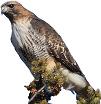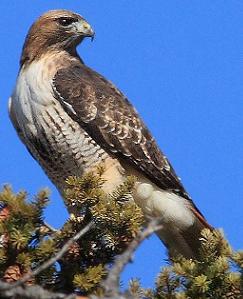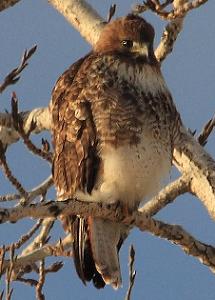Red tailed Hawk 
Identification and Pictures
(Buteo jamaicensis)
Red-tailed hawks are very common North
American Buteo hawks. Like all Buteos they are a very large hawk, about 19
to 25 inches. They have broad wings with a wing span of
around 4 feet and, a short wide tail. Typical adult
plumage is dark brown above with a white chest with brown streaks
on the belly, and brown eyes. They get their name
from the most distinguishing feature in adult birds, their
brick-red
tail. The females are larger than males.
Photos by Keith
Lee. The camera I use is the Canon
EOS 40D. Visit All-birds store

Young birds look much similar but the upper
chest is more mottled.
There are a number of subspecies of Red-tailed
hawks, with much
variation in the plumage. There are all dark, rufous, and
very light phases.
The under wings are mottled dark, and light
with a dark band on the leading edge, called the patagial
markings.

Sound
The voice of the Red-tailed hawk is a high pitched descending scream,
like kee-eer. Sound
Preferred Habitat
Red-tailed hawks are found all across North
America. They can be seen in a large variety of
habitats. They like mountains, open woods, prairies,
plains, and agricultural areas. The hawks are often seen
perched on a poll on roadsides. Northern populations may
migrate in winter, but most will stay in their territories all
year.
Breeding and Nesting
During breeding season they do dramatic flight
displays. They will fly in circles until they are very
high, and the male will dive, and then circle back up again.
The two birds will lock talons, and tumble towards the ground
in a free fall, letting go just above the ground. The
hawks are monogamous, normally mating for life, and staying in the
same territory each year. They may have more than one
nest in their territory, and alternate between them. Both
sexes help build a large nest of sticks, and twigs lined with
bark, placed high in a tree or on a cliff. Throughout
the nesting period the nest will have bits of green vegetation
added to it. The female lays 2 to 4 white eggs with brown
spots which she will incubate for 4 to 5 weeks. The
parents will both feed the nestlings. The young birds
will be able to fly in around 45 days, and then the parents will
teach them to hunt.
Food
Red-tail hawks are good hunters, feeding on
small mammals such as rabbits, or other rodents, birds, reptiles,
and insects. They will either soar, or perch on a high
branch, or poll to survey the surrounding area with their sharp
eyes. While soaring they may ride motionless on an air
current, suddenly fold their wings, an shoot down like a
bullet to grab a small bird below. Hawks have binocular vision, and their incredible
sight allows them to see a mouse on the ground while soaring
100 feet up. When they spot their prey they swoop down
on it, there dives can reach over 100 miles an hour.
When they grasp their prey, and clench their toes the talons pierce the vital organs,
and cause instant death.
To learn about other favorite
birds click here.

|
